Analyzing Attitudes and Behavior in Organizational Success: An Essay
VerifiedAdded on 2020/04/07
|9
|2187
|372
Essay
AI Summary
This essay delves into the critical role of attitudes and behavior within organizations, emphasizing their impact on achieving goals and objectives. It explores how individual attitudes influence workplace behavior and performance, highlighting the importance of a positive mindset for both employees and the company. The essay examines factors contributing to job satisfaction, including compensation, superior support, a healthy working environment, and job security, and how these elements are correlated with organizational commitment. It also discusses the significance of leadership and employee motivation in fostering a successful and productive workplace. The essay further investigates the effects of negative attitudes on collaboration, teamwork, and overall organizational performance, while promoting the benefits of positive attitudes in overcoming obstacles and enhancing financial wealth and brand position. The content is supported by various research and studies from different authors.
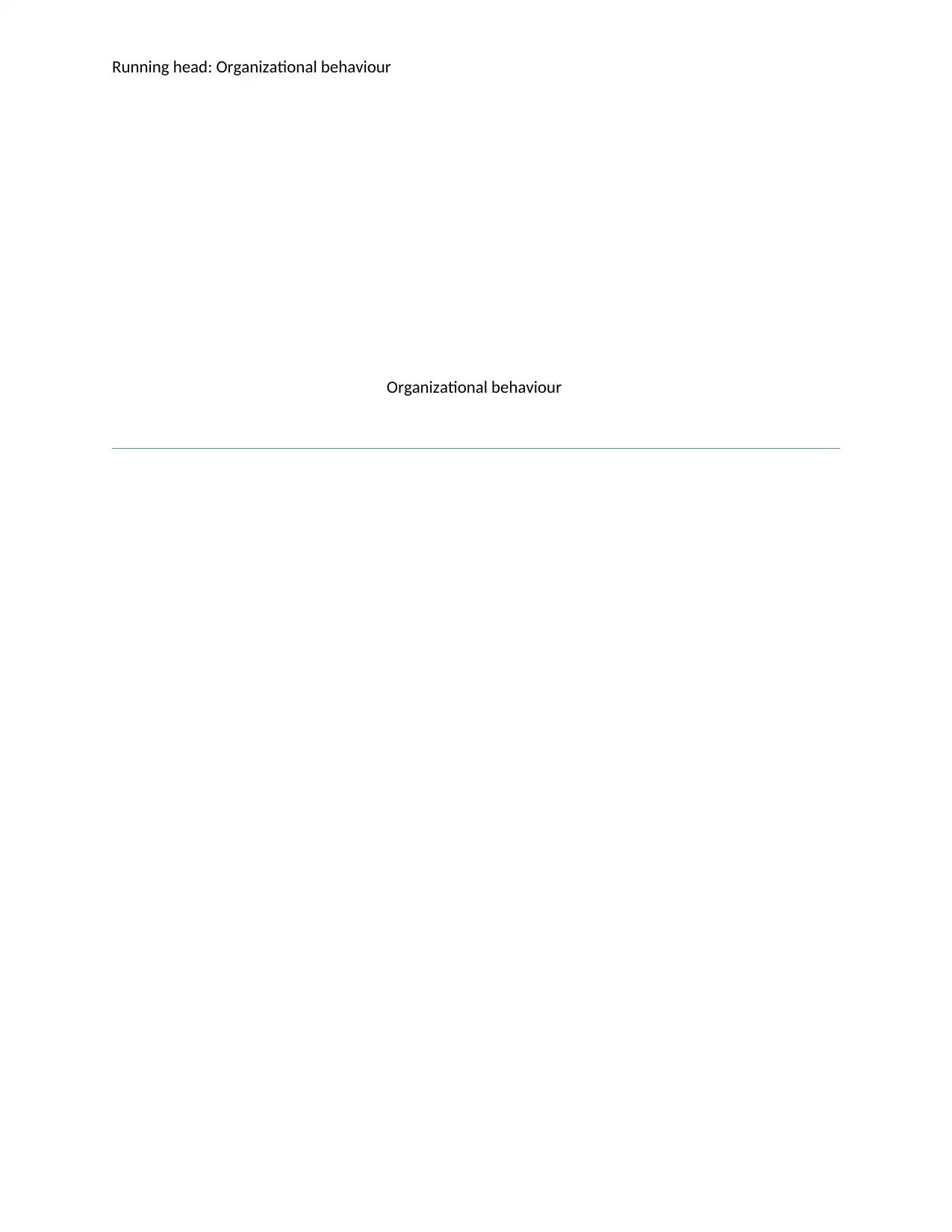
Running head: Organizational behaviour
Organizational behaviour
Organizational behaviour
Paraphrase This Document
Need a fresh take? Get an instant paraphrase of this document with our AI Paraphraser
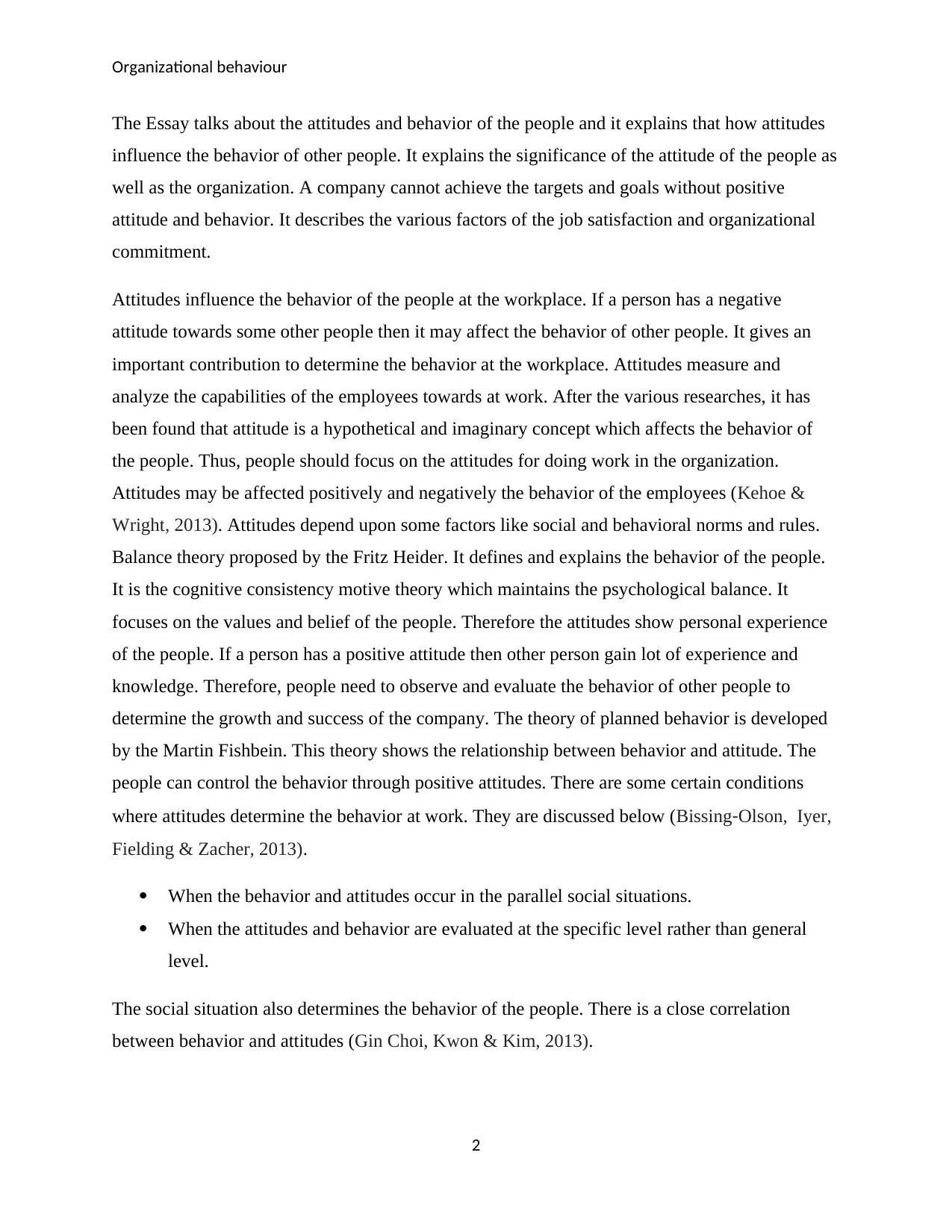
Organizational behaviour
The Essay talks about the attitudes and behavior of the people and it explains that how attitudes
influence the behavior of other people. It explains the significance of the attitude of the people as
well as the organization. A company cannot achieve the targets and goals without positive
attitude and behavior. It describes the various factors of the job satisfaction and organizational
commitment.
Attitudes influence the behavior of the people at the workplace. If a person has a negative
attitude towards some other people then it may affect the behavior of other people. It gives an
important contribution to determine the behavior at the workplace. Attitudes measure and
analyze the capabilities of the employees towards at work. After the various researches, it has
been found that attitude is a hypothetical and imaginary concept which affects the behavior of
the people. Thus, people should focus on the attitudes for doing work in the organization.
Attitudes may be affected positively and negatively the behavior of the employees (Kehoe &
Wright, 2013). Attitudes depend upon some factors like social and behavioral norms and rules.
Balance theory proposed by the Fritz Heider. It defines and explains the behavior of the people.
It is the cognitive consistency motive theory which maintains the psychological balance. It
focuses on the values and belief of the people. Therefore the attitudes show personal experience
of the people. If a person has a positive attitude then other person gain lot of experience and
knowledge. Therefore, people need to observe and evaluate the behavior of other people to
determine the growth and success of the company. The theory of planned behavior is developed
by the Martin Fishbein. This theory shows the relationship between behavior and attitude. The
people can control the behavior through positive attitudes. There are some certain conditions
where attitudes determine the behavior at work. They are discussed below (Bissing‐Olson, Iyer,
Fielding & Zacher, 2013).
When the behavior and attitudes occur in the parallel social situations.
When the attitudes and behavior are evaluated at the specific level rather than general
level.
The social situation also determines the behavior of the people. There is a close correlation
between behavior and attitudes (Gin Choi, Kwon & Kim, 2013).
2
The Essay talks about the attitudes and behavior of the people and it explains that how attitudes
influence the behavior of other people. It explains the significance of the attitude of the people as
well as the organization. A company cannot achieve the targets and goals without positive
attitude and behavior. It describes the various factors of the job satisfaction and organizational
commitment.
Attitudes influence the behavior of the people at the workplace. If a person has a negative
attitude towards some other people then it may affect the behavior of other people. It gives an
important contribution to determine the behavior at the workplace. Attitudes measure and
analyze the capabilities of the employees towards at work. After the various researches, it has
been found that attitude is a hypothetical and imaginary concept which affects the behavior of
the people. Thus, people should focus on the attitudes for doing work in the organization.
Attitudes may be affected positively and negatively the behavior of the employees (Kehoe &
Wright, 2013). Attitudes depend upon some factors like social and behavioral norms and rules.
Balance theory proposed by the Fritz Heider. It defines and explains the behavior of the people.
It is the cognitive consistency motive theory which maintains the psychological balance. It
focuses on the values and belief of the people. Therefore the attitudes show personal experience
of the people. If a person has a positive attitude then other person gain lot of experience and
knowledge. Therefore, people need to observe and evaluate the behavior of other people to
determine the growth and success of the company. The theory of planned behavior is developed
by the Martin Fishbein. This theory shows the relationship between behavior and attitude. The
people can control the behavior through positive attitudes. There are some certain conditions
where attitudes determine the behavior at work. They are discussed below (Bissing‐Olson, Iyer,
Fielding & Zacher, 2013).
When the behavior and attitudes occur in the parallel social situations.
When the attitudes and behavior are evaluated at the specific level rather than general
level.
The social situation also determines the behavior of the people. There is a close correlation
between behavior and attitudes (Gin Choi, Kwon & Kim, 2013).
2
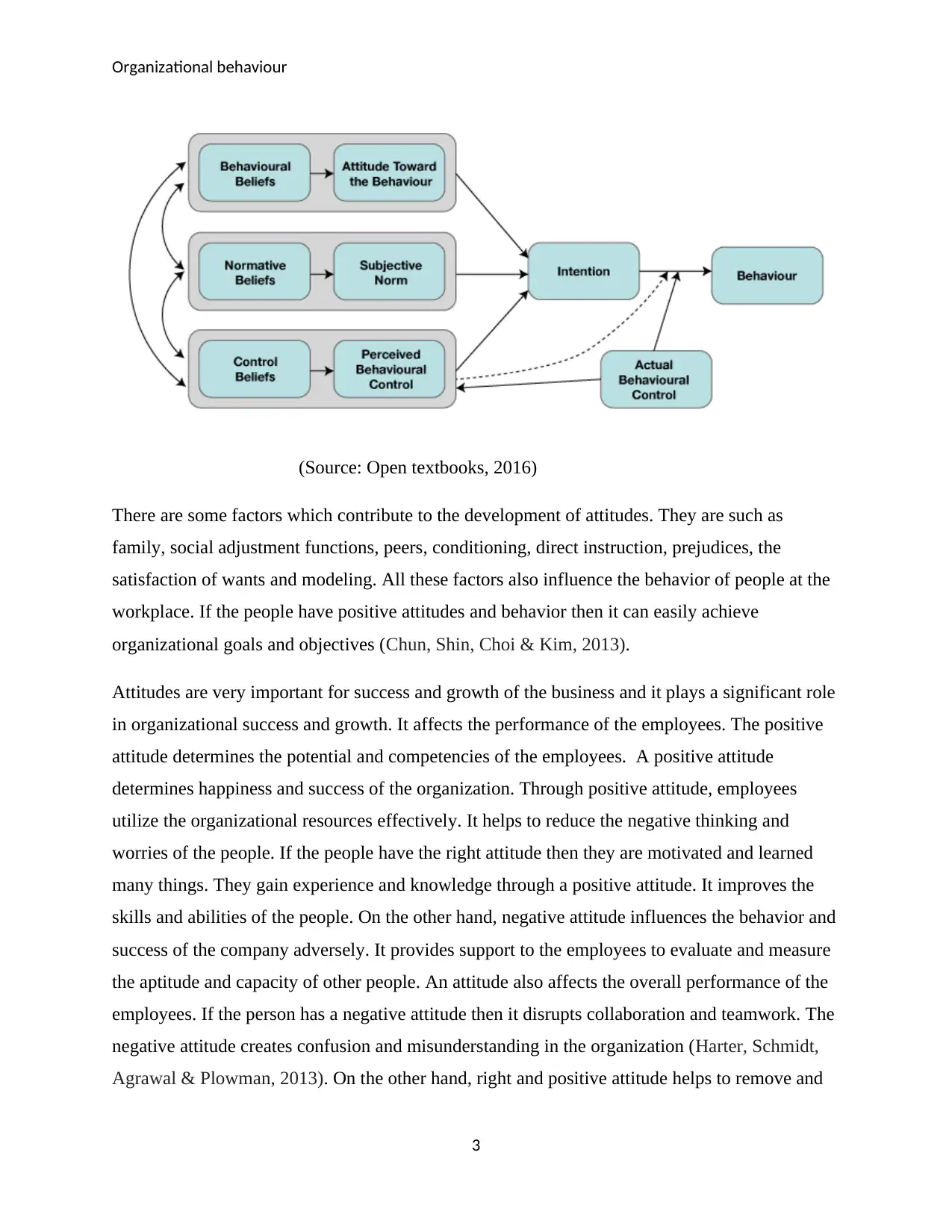
Organizational behaviour
(Source: Open textbooks, 2016)
There are some factors which contribute to the development of attitudes. They are such as
family, social adjustment functions, peers, conditioning, direct instruction, prejudices, the
satisfaction of wants and modeling. All these factors also influence the behavior of people at the
workplace. If the people have positive attitudes and behavior then it can easily achieve
organizational goals and objectives (Chun, Shin, Choi & Kim, 2013).
Attitudes are very important for success and growth of the business and it plays a significant role
in organizational success and growth. It affects the performance of the employees. The positive
attitude determines the potential and competencies of the employees. A positive attitude
determines happiness and success of the organization. Through positive attitude, employees
utilize the organizational resources effectively. It helps to reduce the negative thinking and
worries of the people. If the people have the right attitude then they are motivated and learned
many things. They gain experience and knowledge through a positive attitude. It improves the
skills and abilities of the people. On the other hand, negative attitude influences the behavior and
success of the company adversely. It provides support to the employees to evaluate and measure
the aptitude and capacity of other people. An attitude also affects the overall performance of the
employees. If the person has a negative attitude then it disrupts collaboration and teamwork. The
negative attitude creates confusion and misunderstanding in the organization (Harter, Schmidt,
Agrawal & Plowman, 2013). On the other hand, right and positive attitude helps to remove and
3
(Source: Open textbooks, 2016)
There are some factors which contribute to the development of attitudes. They are such as
family, social adjustment functions, peers, conditioning, direct instruction, prejudices, the
satisfaction of wants and modeling. All these factors also influence the behavior of people at the
workplace. If the people have positive attitudes and behavior then it can easily achieve
organizational goals and objectives (Chun, Shin, Choi & Kim, 2013).
Attitudes are very important for success and growth of the business and it plays a significant role
in organizational success and growth. It affects the performance of the employees. The positive
attitude determines the potential and competencies of the employees. A positive attitude
determines happiness and success of the organization. Through positive attitude, employees
utilize the organizational resources effectively. It helps to reduce the negative thinking and
worries of the people. If the people have the right attitude then they are motivated and learned
many things. They gain experience and knowledge through a positive attitude. It improves the
skills and abilities of the people. On the other hand, negative attitude influences the behavior and
success of the company adversely. It provides support to the employees to evaluate and measure
the aptitude and capacity of other people. An attitude also affects the overall performance of the
employees. If the person has a negative attitude then it disrupts collaboration and teamwork. The
negative attitude creates confusion and misunderstanding in the organization (Harter, Schmidt,
Agrawal & Plowman, 2013). On the other hand, right and positive attitude helps to remove and
3
⊘ This is a preview!⊘
Do you want full access?
Subscribe today to unlock all pages.

Trusted by 1+ million students worldwide
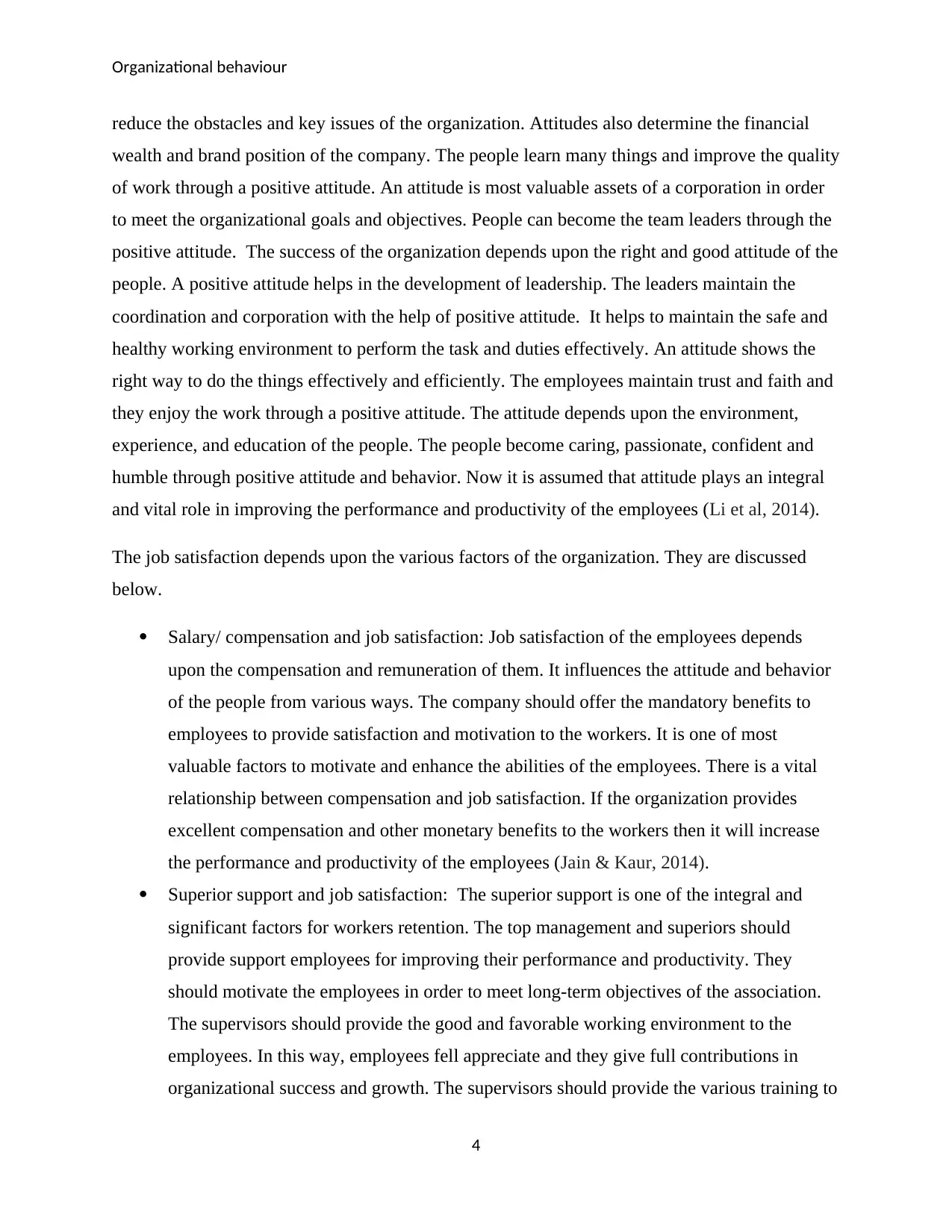
Organizational behaviour
reduce the obstacles and key issues of the organization. Attitudes also determine the financial
wealth and brand position of the company. The people learn many things and improve the quality
of work through a positive attitude. An attitude is most valuable assets of a corporation in order
to meet the organizational goals and objectives. People can become the team leaders through the
positive attitude. The success of the organization depends upon the right and good attitude of the
people. A positive attitude helps in the development of leadership. The leaders maintain the
coordination and corporation with the help of positive attitude. It helps to maintain the safe and
healthy working environment to perform the task and duties effectively. An attitude shows the
right way to do the things effectively and efficiently. The employees maintain trust and faith and
they enjoy the work through a positive attitude. The attitude depends upon the environment,
experience, and education of the people. The people become caring, passionate, confident and
humble through positive attitude and behavior. Now it is assumed that attitude plays an integral
and vital role in improving the performance and productivity of the employees (Li et al, 2014).
The job satisfaction depends upon the various factors of the organization. They are discussed
below.
Salary/ compensation and job satisfaction: Job satisfaction of the employees depends
upon the compensation and remuneration of them. It influences the attitude and behavior
of the people from various ways. The company should offer the mandatory benefits to
employees to provide satisfaction and motivation to the workers. It is one of most
valuable factors to motivate and enhance the abilities of the employees. There is a vital
relationship between compensation and job satisfaction. If the organization provides
excellent compensation and other monetary benefits to the workers then it will increase
the performance and productivity of the employees (Jain & Kaur, 2014).
Superior support and job satisfaction: The superior support is one of the integral and
significant factors for workers retention. The top management and superiors should
provide support employees for improving their performance and productivity. They
should motivate the employees in order to meet long-term objectives of the association.
The supervisors should provide the good and favorable working environment to the
employees. In this way, employees fell appreciate and they give full contributions in
organizational success and growth. The supervisors should provide the various training to
4
reduce the obstacles and key issues of the organization. Attitudes also determine the financial
wealth and brand position of the company. The people learn many things and improve the quality
of work through a positive attitude. An attitude is most valuable assets of a corporation in order
to meet the organizational goals and objectives. People can become the team leaders through the
positive attitude. The success of the organization depends upon the right and good attitude of the
people. A positive attitude helps in the development of leadership. The leaders maintain the
coordination and corporation with the help of positive attitude. It helps to maintain the safe and
healthy working environment to perform the task and duties effectively. An attitude shows the
right way to do the things effectively and efficiently. The employees maintain trust and faith and
they enjoy the work through a positive attitude. The attitude depends upon the environment,
experience, and education of the people. The people become caring, passionate, confident and
humble through positive attitude and behavior. Now it is assumed that attitude plays an integral
and vital role in improving the performance and productivity of the employees (Li et al, 2014).
The job satisfaction depends upon the various factors of the organization. They are discussed
below.
Salary/ compensation and job satisfaction: Job satisfaction of the employees depends
upon the compensation and remuneration of them. It influences the attitude and behavior
of the people from various ways. The company should offer the mandatory benefits to
employees to provide satisfaction and motivation to the workers. It is one of most
valuable factors to motivate and enhance the abilities of the employees. There is a vital
relationship between compensation and job satisfaction. If the organization provides
excellent compensation and other monetary benefits to the workers then it will increase
the performance and productivity of the employees (Jain & Kaur, 2014).
Superior support and job satisfaction: The superior support is one of the integral and
significant factors for workers retention. The top management and superiors should
provide support employees for improving their performance and productivity. They
should motivate the employees in order to meet long-term objectives of the association.
The supervisors should provide the good and favorable working environment to the
employees. In this way, employees fell appreciate and they give full contributions in
organizational success and growth. The supervisors should provide the various training to
4
Paraphrase This Document
Need a fresh take? Get an instant paraphrase of this document with our AI Paraphraser
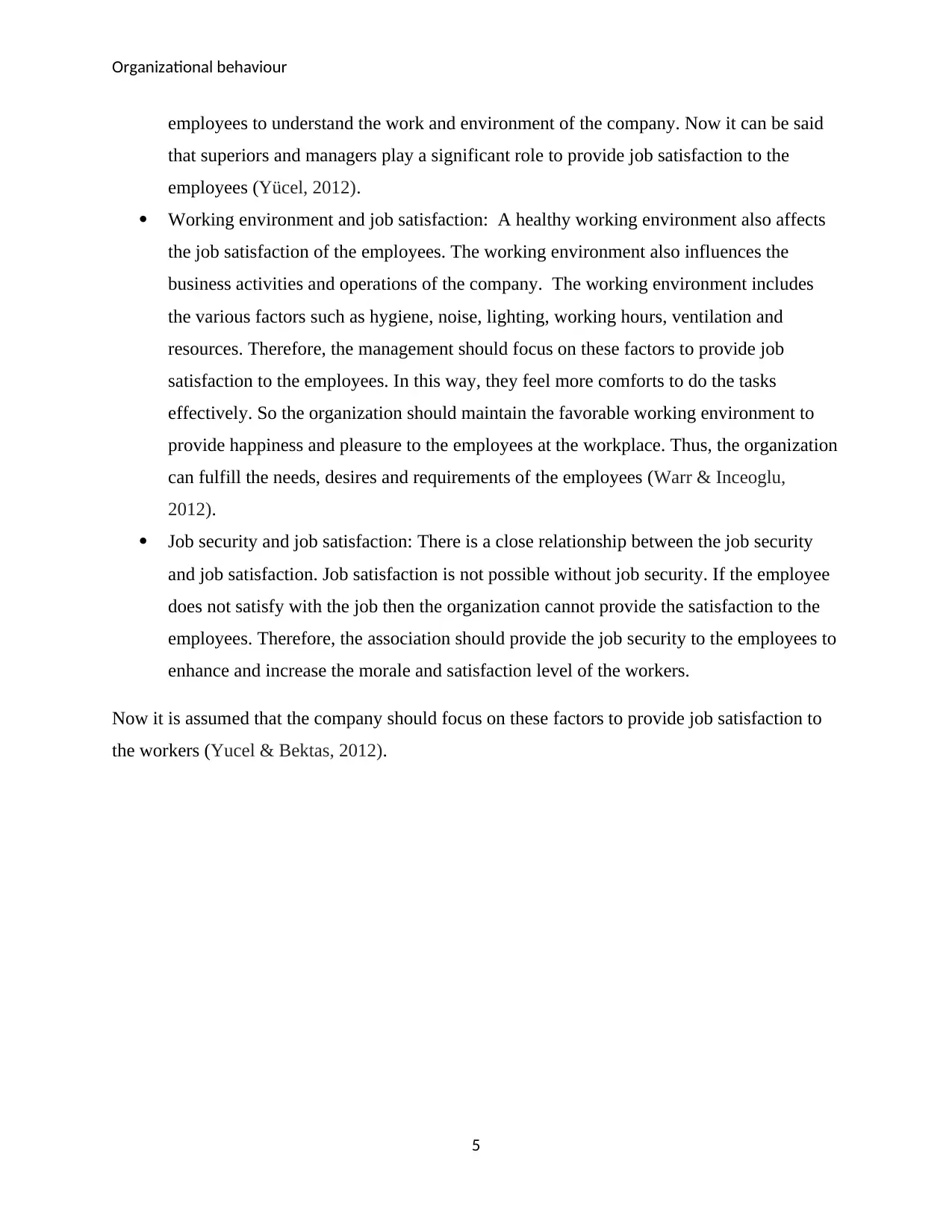
Organizational behaviour
employees to understand the work and environment of the company. Now it can be said
that superiors and managers play a significant role to provide job satisfaction to the
employees (Yücel, 2012).
Working environment and job satisfaction: A healthy working environment also affects
the job satisfaction of the employees. The working environment also influences the
business activities and operations of the company. The working environment includes
the various factors such as hygiene, noise, lighting, working hours, ventilation and
resources. Therefore, the management should focus on these factors to provide job
satisfaction to the employees. In this way, they feel more comforts to do the tasks
effectively. So the organization should maintain the favorable working environment to
provide happiness and pleasure to the employees at the workplace. Thus, the organization
can fulfill the needs, desires and requirements of the employees (Warr & Inceoglu,
2012).
Job security and job satisfaction: There is a close relationship between the job security
and job satisfaction. Job satisfaction is not possible without job security. If the employee
does not satisfy with the job then the organization cannot provide the satisfaction to the
employees. Therefore, the association should provide the job security to the employees to
enhance and increase the morale and satisfaction level of the workers.
Now it is assumed that the company should focus on these factors to provide job satisfaction to
the workers (Yucel & Bektas, 2012).
5
employees to understand the work and environment of the company. Now it can be said
that superiors and managers play a significant role to provide job satisfaction to the
employees (Yücel, 2012).
Working environment and job satisfaction: A healthy working environment also affects
the job satisfaction of the employees. The working environment also influences the
business activities and operations of the company. The working environment includes
the various factors such as hygiene, noise, lighting, working hours, ventilation and
resources. Therefore, the management should focus on these factors to provide job
satisfaction to the employees. In this way, they feel more comforts to do the tasks
effectively. So the organization should maintain the favorable working environment to
provide happiness and pleasure to the employees at the workplace. Thus, the organization
can fulfill the needs, desires and requirements of the employees (Warr & Inceoglu,
2012).
Job security and job satisfaction: There is a close relationship between the job security
and job satisfaction. Job satisfaction is not possible without job security. If the employee
does not satisfy with the job then the organization cannot provide the satisfaction to the
employees. Therefore, the association should provide the job security to the employees to
enhance and increase the morale and satisfaction level of the workers.
Now it is assumed that the company should focus on these factors to provide job satisfaction to
the workers (Yucel & Bektas, 2012).
5
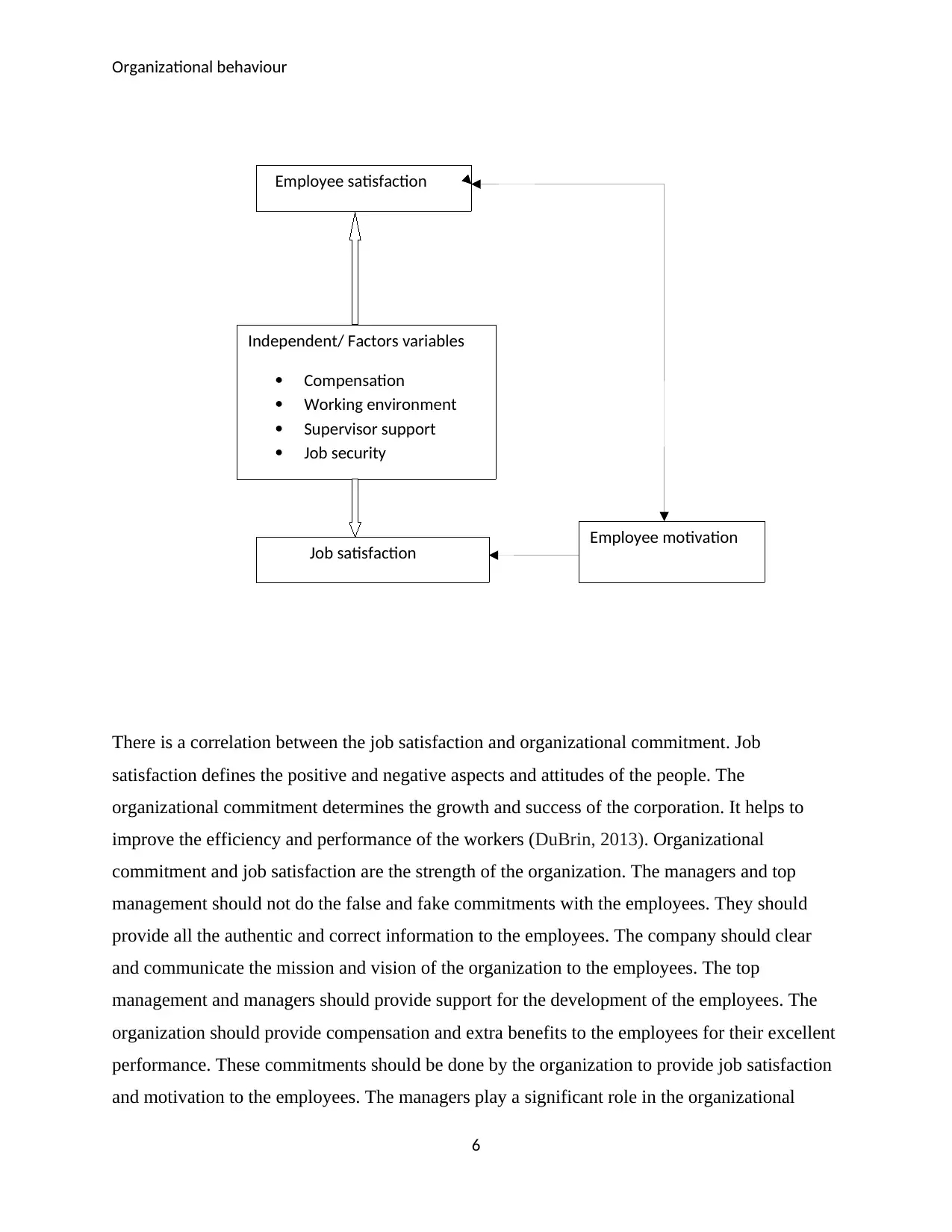
Organizational behaviour
There is a correlation between the job satisfaction and organizational commitment. Job
satisfaction defines the positive and negative aspects and attitudes of the people. The
organizational commitment determines the growth and success of the corporation. It helps to
improve the efficiency and performance of the workers (DuBrin, 2013). Organizational
commitment and job satisfaction are the strength of the organization. The managers and top
management should not do the false and fake commitments with the employees. They should
provide all the authentic and correct information to the employees. The company should clear
and communicate the mission and vision of the organization to the employees. The top
management and managers should provide support for the development of the employees. The
organization should provide compensation and extra benefits to the employees for their excellent
performance. These commitments should be done by the organization to provide job satisfaction
and motivation to the employees. The managers play a significant role in the organizational
6
Employee satisfaction
Independent/ Factors variables
Compensation
Working environment
Supervisor support
Job security
Job satisfaction Employee motivation
There is a correlation between the job satisfaction and organizational commitment. Job
satisfaction defines the positive and negative aspects and attitudes of the people. The
organizational commitment determines the growth and success of the corporation. It helps to
improve the efficiency and performance of the workers (DuBrin, 2013). Organizational
commitment and job satisfaction are the strength of the organization. The managers and top
management should not do the false and fake commitments with the employees. They should
provide all the authentic and correct information to the employees. The company should clear
and communicate the mission and vision of the organization to the employees. The top
management and managers should provide support for the development of the employees. The
organization should provide compensation and extra benefits to the employees for their excellent
performance. These commitments should be done by the organization to provide job satisfaction
and motivation to the employees. The managers play a significant role in the organizational
6
Employee satisfaction
Independent/ Factors variables
Compensation
Working environment
Supervisor support
Job security
Job satisfaction Employee motivation
⊘ This is a preview!⊘
Do you want full access?
Subscribe today to unlock all pages.

Trusted by 1+ million students worldwide
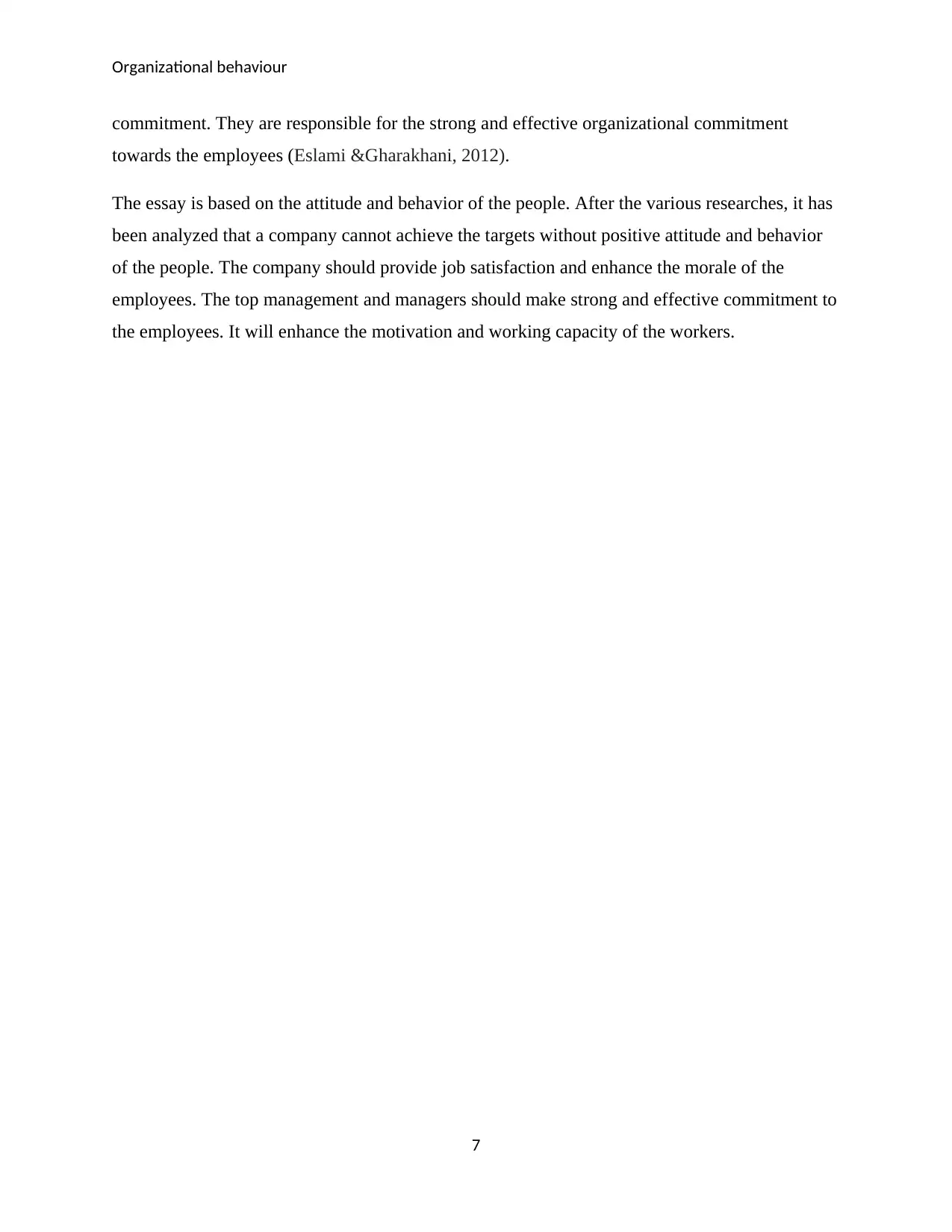
Organizational behaviour
commitment. They are responsible for the strong and effective organizational commitment
towards the employees (Eslami &Gharakhani, 2012).
The essay is based on the attitude and behavior of the people. After the various researches, it has
been analyzed that a company cannot achieve the targets without positive attitude and behavior
of the people. The company should provide job satisfaction and enhance the morale of the
employees. The top management and managers should make strong and effective commitment to
the employees. It will enhance the motivation and working capacity of the workers.
7
commitment. They are responsible for the strong and effective organizational commitment
towards the employees (Eslami &Gharakhani, 2012).
The essay is based on the attitude and behavior of the people. After the various researches, it has
been analyzed that a company cannot achieve the targets without positive attitude and behavior
of the people. The company should provide job satisfaction and enhance the morale of the
employees. The top management and managers should make strong and effective commitment to
the employees. It will enhance the motivation and working capacity of the workers.
7
Paraphrase This Document
Need a fresh take? Get an instant paraphrase of this document with our AI Paraphraser
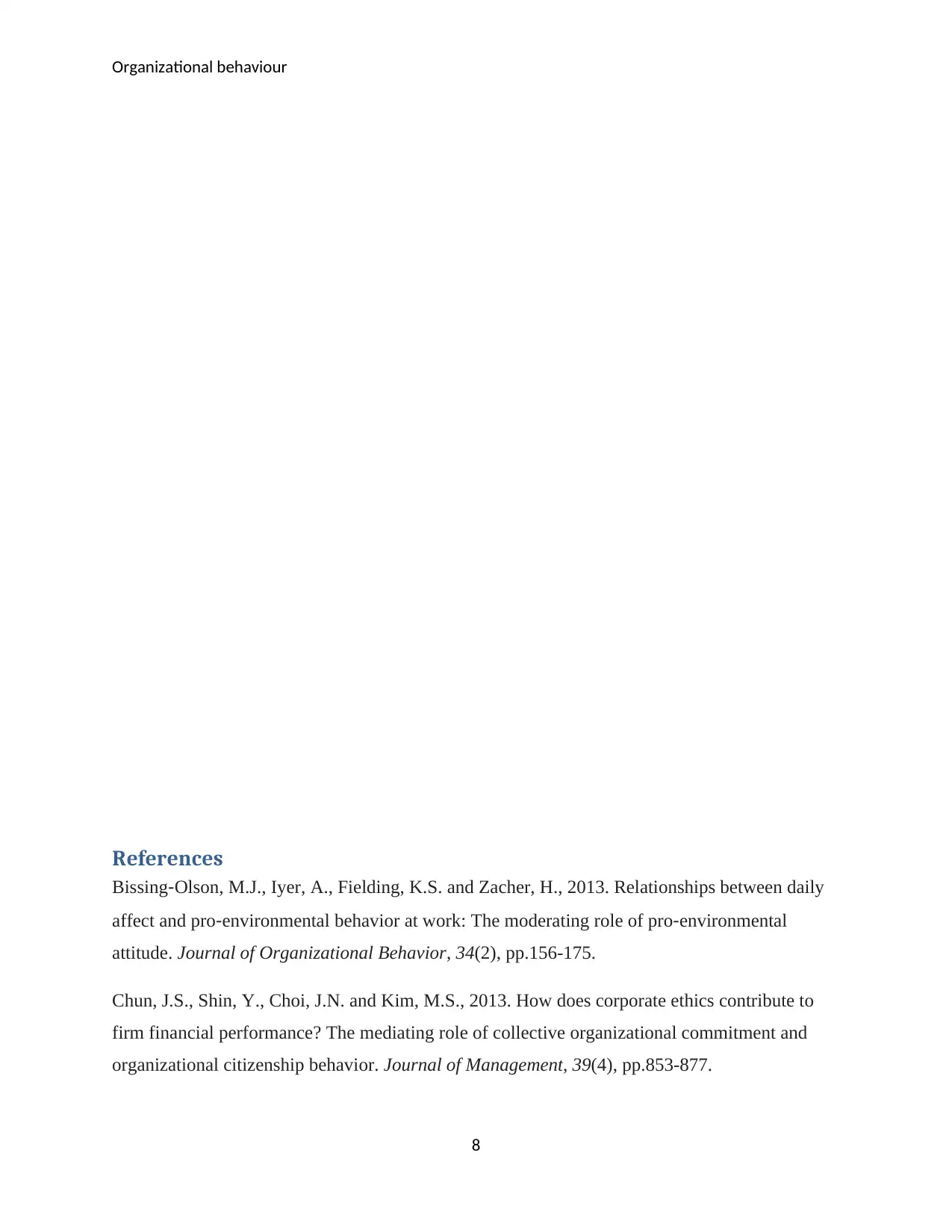
Organizational behaviour
References
Bissing‐Olson, M.J., Iyer, A., Fielding, K.S. and Zacher, H., 2013. Relationships between daily
affect and pro‐environmental behavior at work: The moderating role of pro‐environmental
attitude. Journal of Organizational Behavior, 34(2), pp.156-175.
Chun, J.S., Shin, Y., Choi, J.N. and Kim, M.S., 2013. How does corporate ethics contribute to
firm financial performance? The mediating role of collective organizational commitment and
organizational citizenship behavior. Journal of Management, 39(4), pp.853-877.
8
References
Bissing‐Olson, M.J., Iyer, A., Fielding, K.S. and Zacher, H., 2013. Relationships between daily
affect and pro‐environmental behavior at work: The moderating role of pro‐environmental
attitude. Journal of Organizational Behavior, 34(2), pp.156-175.
Chun, J.S., Shin, Y., Choi, J.N. and Kim, M.S., 2013. How does corporate ethics contribute to
firm financial performance? The mediating role of collective organizational commitment and
organizational citizenship behavior. Journal of Management, 39(4), pp.853-877.
8
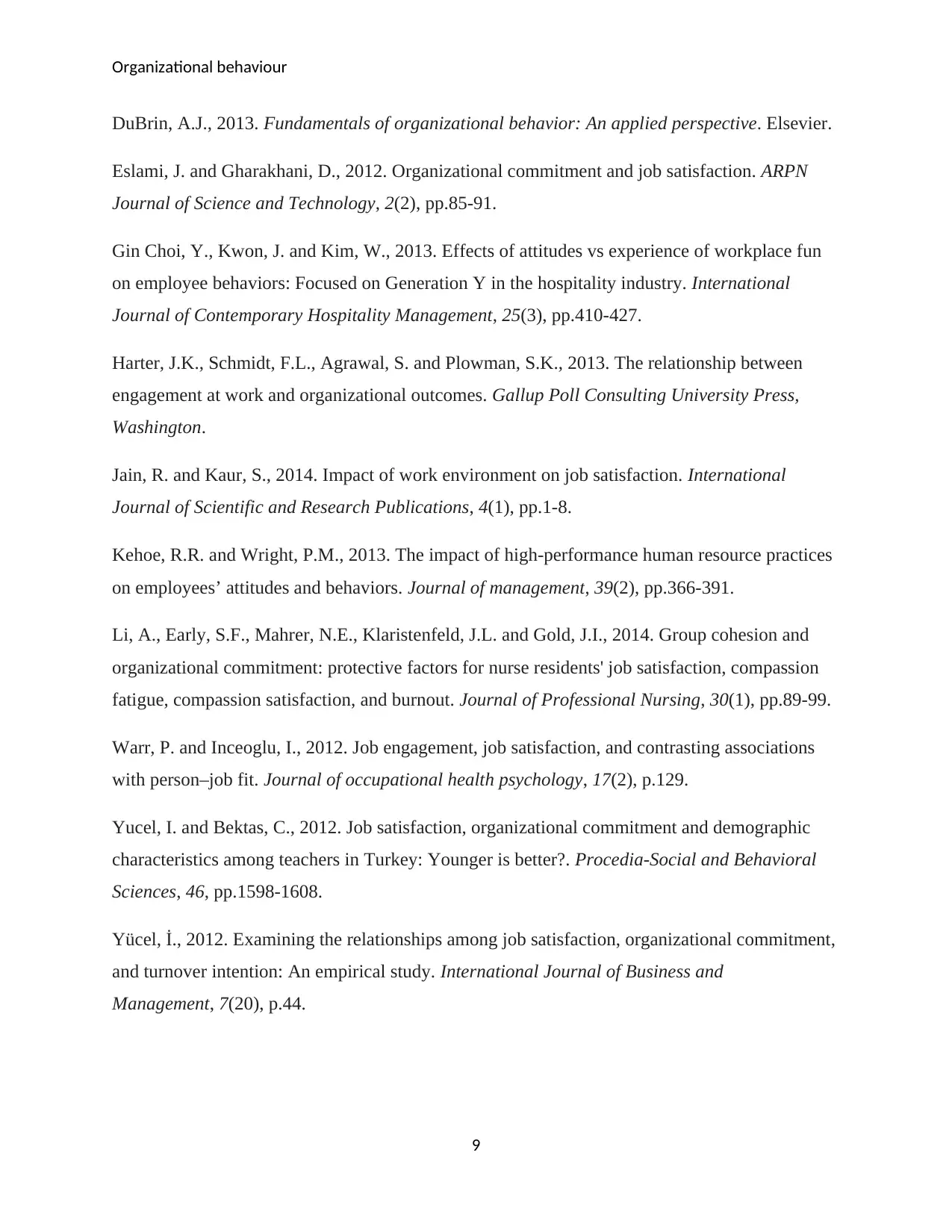
Organizational behaviour
DuBrin, A.J., 2013. Fundamentals of organizational behavior: An applied perspective. Elsevier.
Eslami, J. and Gharakhani, D., 2012. Organizational commitment and job satisfaction. ARPN
Journal of Science and Technology, 2(2), pp.85-91.
Gin Choi, Y., Kwon, J. and Kim, W., 2013. Effects of attitudes vs experience of workplace fun
on employee behaviors: Focused on Generation Y in the hospitality industry. International
Journal of Contemporary Hospitality Management, 25(3), pp.410-427.
Harter, J.K., Schmidt, F.L., Agrawal, S. and Plowman, S.K., 2013. The relationship between
engagement at work and organizational outcomes. Gallup Poll Consulting University Press,
Washington.
Jain, R. and Kaur, S., 2014. Impact of work environment on job satisfaction. International
Journal of Scientific and Research Publications, 4(1), pp.1-8.
Kehoe, R.R. and Wright, P.M., 2013. The impact of high-performance human resource practices
on employees’ attitudes and behaviors. Journal of management, 39(2), pp.366-391.
Li, A., Early, S.F., Mahrer, N.E., Klaristenfeld, J.L. and Gold, J.I., 2014. Group cohesion and
organizational commitment: protective factors for nurse residents' job satisfaction, compassion
fatigue, compassion satisfaction, and burnout. Journal of Professional Nursing, 30(1), pp.89-99.
Warr, P. and Inceoglu, I., 2012. Job engagement, job satisfaction, and contrasting associations
with person–job fit. Journal of occupational health psychology, 17(2), p.129.
Yucel, I. and Bektas, C., 2012. Job satisfaction, organizational commitment and demographic
characteristics among teachers in Turkey: Younger is better?. Procedia-Social and Behavioral
Sciences, 46, pp.1598-1608.
Yücel, İ., 2012. Examining the relationships among job satisfaction, organizational commitment,
and turnover intention: An empirical study. International Journal of Business and
Management, 7(20), p.44.
9
DuBrin, A.J., 2013. Fundamentals of organizational behavior: An applied perspective. Elsevier.
Eslami, J. and Gharakhani, D., 2012. Organizational commitment and job satisfaction. ARPN
Journal of Science and Technology, 2(2), pp.85-91.
Gin Choi, Y., Kwon, J. and Kim, W., 2013. Effects of attitudes vs experience of workplace fun
on employee behaviors: Focused on Generation Y in the hospitality industry. International
Journal of Contemporary Hospitality Management, 25(3), pp.410-427.
Harter, J.K., Schmidt, F.L., Agrawal, S. and Plowman, S.K., 2013. The relationship between
engagement at work and organizational outcomes. Gallup Poll Consulting University Press,
Washington.
Jain, R. and Kaur, S., 2014. Impact of work environment on job satisfaction. International
Journal of Scientific and Research Publications, 4(1), pp.1-8.
Kehoe, R.R. and Wright, P.M., 2013. The impact of high-performance human resource practices
on employees’ attitudes and behaviors. Journal of management, 39(2), pp.366-391.
Li, A., Early, S.F., Mahrer, N.E., Klaristenfeld, J.L. and Gold, J.I., 2014. Group cohesion and
organizational commitment: protective factors for nurse residents' job satisfaction, compassion
fatigue, compassion satisfaction, and burnout. Journal of Professional Nursing, 30(1), pp.89-99.
Warr, P. and Inceoglu, I., 2012. Job engagement, job satisfaction, and contrasting associations
with person–job fit. Journal of occupational health psychology, 17(2), p.129.
Yucel, I. and Bektas, C., 2012. Job satisfaction, organizational commitment and demographic
characteristics among teachers in Turkey: Younger is better?. Procedia-Social and Behavioral
Sciences, 46, pp.1598-1608.
Yücel, İ., 2012. Examining the relationships among job satisfaction, organizational commitment,
and turnover intention: An empirical study. International Journal of Business and
Management, 7(20), p.44.
9
⊘ This is a preview!⊘
Do you want full access?
Subscribe today to unlock all pages.

Trusted by 1+ million students worldwide
1 out of 9
Related Documents
Your All-in-One AI-Powered Toolkit for Academic Success.
+13062052269
info@desklib.com
Available 24*7 on WhatsApp / Email
![[object Object]](/_next/static/media/star-bottom.7253800d.svg)
Unlock your academic potential
Copyright © 2020–2025 A2Z Services. All Rights Reserved. Developed and managed by ZUCOL.





